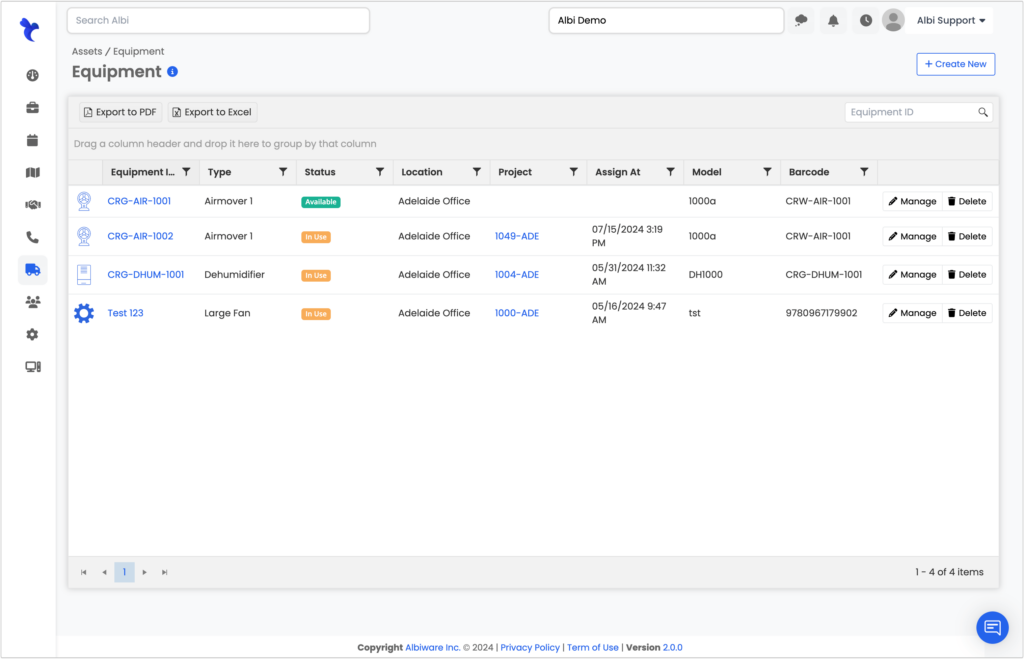Chris has been in the restoration industry since 1999. He began his career working for Stanley Steemer of Fort Wayne and eventually worked his way up to founding Water Out of Fort Wayne. Chris is a passionate restorer and also an instructor at the Dewald Academy of Drying. We are honored to have him moderate this debate between Alex and Mike.
Optimizing Your Restoration Inventory:
Last updated: September 19th, 2024
Contents
A crucial part of many businesses involves keeping sufficient supplies on hand and tracking necessary equipment. Management software made specifically for the restoration industry helps ensure restorers have enough of what they need to do their jobs effectively. Additionally, it allows them to track valuable equipment so that it’s used efficiently. Unlike a retail business that needs to look after the inventory it sells to customers, restoration contractors need to secure the right supplies for a project, often during a time when many others are seeking the same materials.
Meanwhile, they also need to ensure their own tools and equipment are on hand for a project when needed. Inventory control can frustrate even the most patient of restorers. It may be as simple as being unable to find a heavy-duty extension cord for a job or a call from a project manager saying an expensive dehumidifier has been left at an out-of-the-way jobsite over the weekend. In many ways, it’s more important for a restoration contractor than for other businesses to keep track of their tools and equipment. Management software for restoration companies enables contractors to have more control over their inventory to do their jobs more efficiently to fulfill their commitments to their customers.
Optimize your restoration projects with Albi’s management software. Schedule a free demo today to see how we can streamline your workflow and enhance your communication with stakeholders.
Importance of Equipment Management Software
Every piece of equipment and each tool a restoration company uses is important to achieving its goal: to restore structures to their original state. Because these things are so important to the very existence of a restoration business, it’s important to keep track of the most vital equipment. Management software for restoration contractors should thus have a way to track such valuable assets effectively.
Managing inventory should consider the costs incurred from keeping an item on hand, including expenses associated with insuring, storing, and tracking assets. It’s important that restoration contractors keep enough supplies on hand to do their jobs to avoid work stoppages without the extra costs of insuring, storing, and tracking equipment. Management software helps restorers keep an accurate record of their equipment, supplies, and tools to keep the company operating efficiently and productively.

Typical Supplies & Equipment Used in the Restoration Industry
Restoration companies must work on restoring structures damaged by fires, floods, serious mold growth, storms, and other disasters. To deal with this array of disasters, restorers must keep certain equipment, supplies, and tools on hand. Many restoration contractors focus on certain areas, so require specific tools like air movers, dehumidifiers, and moisture meters for dealing with water damage.
Equipment management software can also be used to keep track of supplies and equipment like:
- Air movers: Used to dry carpeting and other flooring damaged by water, these are unlike fans as they cause air to blow along ground level, resulting in quicker evaporation to remove most water from the floor quickly.
- Air scrubbers: Different from but complementary to air movers, these equipment deal directly with mold growth that can make air dangerous to breathe; air scrubbers draw in contaminated air, capturing pollutants in a filter before pumping out purified air.
- Backhoes: While typically, these will be rented by smaller contractors when needed, for larger restoration companies, a backhoe can be very useful for specific projects that involve digging, landscaping, minor demolition, and moving heavy materials.
- Low grain refrigerant dehumidifiers: These achieve rapid drying of areas by pre-cooling intake air, leading to drier air; offering greater energy efficiency and working more quickly than other types of dehumidifiers, these work best at temperatures above 15°C (59°F).
- Mobile desiccant dehumidifiers: When a structure has been damaged by water, these temporarily control humidity within the interiors of buildings to prevent the growth of molds or fungi; desiccant dehumidifiers offer greater effectiveness in temperatures that are 15°C (59°F) and below.
- Mobile generators: As natural disasters often interrupt power, having a mobile generator on hand ensures that a contractor can work on a project even when there’s no electricity.
- Moisture meters: These tools offer restoration teams a means to evaluate water damage by measuring moisture levels before and after work has been done to remove moisture. It offers two crucial bits of information:
- Measures severity of water damage in certain areas.
- Identifies a source, such as a leaking pipe or burst water main.
- Self-propelled dump containers: In most natural disasters like fires or floods, there will be debris that needs to be removed from the jobsite, which a self-propelled dump container makes an easier and quicker task.
- Vehicles: Whether a utility van, pickup truck, or other company vehicles, without transport for their teams, supplies, and equipment restoration contractors couldn’t do their jobs; certain vehicles like vans, for example, can also serve as storage for tools and other equipment.
There are, of course, many more tools, supplies, and equipment that could be added to this list, depending on a restoration company’s focus. These might include containment walls, ducting, odor eliminators, sealers, sprayers, tools for removing smoke or soot, and other equipment. Management software can help restoration contractors keep track of it all.
Benefits & Features of Equipment Management Software
The software offers numerous benefits to a restoration company for effective equipment management. Equipment management software improves customer satisfaction by streamlining the time it takes from a customer signing a contract to the contractor finishing the job. It staves off delays from understocking some supplies while saving on costs for storing materials that won’t be readily used. Software for managing equipment also optimizes project scheduling by ensuring the right supplies, materials, and equipment are available when needed.
An important yet time-consuming aspect of the restoration industry involves cataloging inventory and documenting what’s needed, especially supplies, materials, and equipment. Management software makes documentation easier, making a task that was once manual and tedious to a task that’s automated and quick. Inventory management helps a restoration company become more efficient while providing quantifiable benefits, leading to greater profitability.
Using equipment management software has features to help:
- Document records for the current equipment condition and any maintenance records for such.
- Ensure supplies are available for a project.
- Identify where in the field an asset is and which team currently has it.
- Preserve records like date of purchase and serial numbers for all assets, including equipment, materials, and supplies.
- Track where assets are in real-time.
Knowing where assets are at any moment is integral to any restorer equipment. Management software that can track assets offers project managers a means to identify things such as where the nearest air mover is and which team has it. Equipment management allows contractors to know where their equipment is in real-time.
Tracking Equipment in Real-Time
One feature that’s especially important to a busy restoration company is the ability to track assets in real-time. Equipment management software should enable project managers to use their cellphone or other mobile device to check where assets are and who has them. Mobile software applications allow stakeholders to quickly answer questions from customers or other stakeholders regarding when a certain piece of equipment will reach the jobsite. Knowing where an asset is at any moment in time allows just this.
The Importance of Effective Equipment Management Software
Equipment management software should have effective tools to manage a restoration company’s inventory. It should also be scalable, so a smaller contractor with fewer tools and less equipment need not spend for capabilities they don’t need while enabling that same contractor to upscale their operations when business opportunities warrant expansion. Software for managing equipment and supplies should also be easily configurable so that new technology can be integrated into the platform. Albi does all this and more.
Albi allows restoration contractors to:
- Assign equipment to specific teams or jobsites.
- Manage costs for equipment, materials, and supplies more efficiently.
- Permit project managers to see where equipment is in real time.
- Speed jobs by optimizing workflows, which in turn improves customer satisfaction and results in cost savings.
- Summarize assets along with where they’re located.
For restorers looking to augment the efficiency of their operations, Albi is software that helps contractors better manage their tools and equipment. Management software for restoration companies should also be built by people who know the business. Albi is restoration software developed and designed by seasoned experts in the industry. To discover more about Albi and what it can do for your restoration business, book a free demo today.
What you should do now
- Get a Free Demo and see how Albiware can help solve your restoration software challenges.
- Read more articles in our blog.
- If you know someone who’d enjoy this article, share it with them via Facebook, Twitter, LinkedIn, or email.
